Overview
The Qu’aiti (pronounced “Qu’aiti” or “G’aiti”) tribe from which the ruling dynasty hails and hence the name, is one of the member tribes of the Mausatta Confederacy of the tribes of Upper Yafa’, a green highland region known for the independent-mindedness, valour and fighting qualities of its men. All Yafa’is are descendants of the ancient Himyarites, who had founded two great empires prior to the advent of Islam and hence are also referred to as “Beni Himyar” or the “sons of Himyar”.
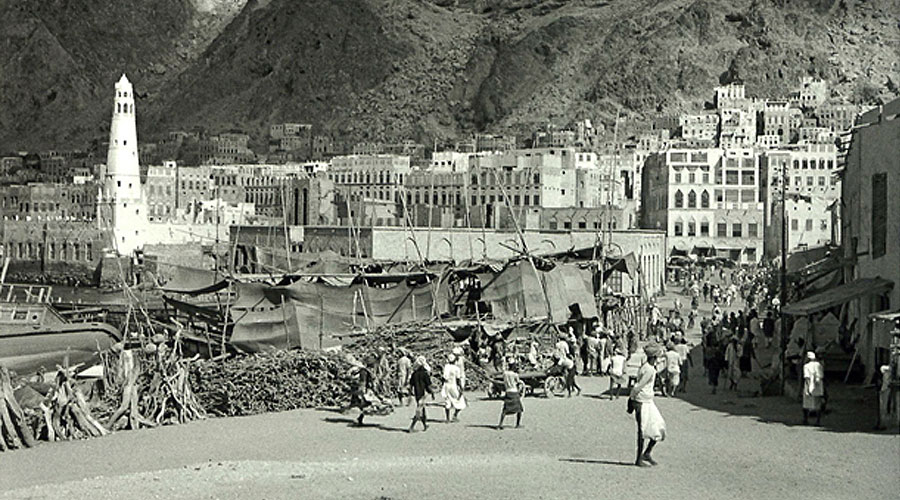 Al-Mukalla Harbour in the 1950s
Al-Mukalla Harbour in the 1950s
The Yafa’is from times immemorial had a tradition for hiring themselves out as mercenaries and it was in this capacity that they were initially introduced into Hadhramaut in the 10th, 11th and 12th centuries of the Islamic Hijra (H) to assist local princes defend themselves, establish and assert their authority and to maintain law and order for them.
The ancestors of the Qu’aiti dynasty had come to Hadhramaut with these mercenaries and had been settled at a small village Lahroom not far from Shibam, the legendary town with the mud skyscrapers.
Some tradition has it that Awadh bin Abdullah Al-Qu’aiti the father of the founder of the Qu’aiti dynasty had travelled to India and served as a soldier with the Nizam of Hyderabad, dying in battle during the Second Mysore War against Tipu, the Sultan of Mysore. He left behind five sons and several of them travelled to India to seek fortunes as mercenaries.
Omar bin Awadh the founder of Qu’aiti fortunes was born at Lahroom in the 1790’s and is recorded to set off for India in 1228H/1813 AD. He took up service as a “Jem’adar” (Captain of a Group) at the court of the Raja of Nagpur (Berar – with an area of 80,000 sq. miles), where his brother Abdullah was serving. His arrival coincided with his brother’s death and Omar succeeded to his brother’s command and also married the latter’s childless widow.
On the defeat and capture of the Raja Appaji, Omar decided to evacuate the fort in lieu of the settlement of his troops’ arrears and on the condition that, his men would be allowed to march out with their weapons and belongings and escorted into any neighbouring territory of their choosing with a safe passage for those who intended to return home. They were to choose the Nizam's Dominions.
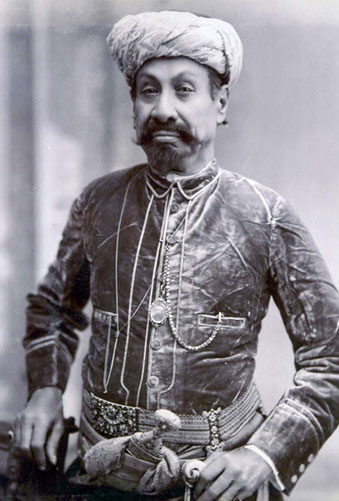 |
| Al-Mukalla Harbour in the 1950s |
Omar took up service there with his Group and rose rapidly to become one of the two chief commanders of Arab mercenaries at the Nizam of Hyderabad’s court. He played a vital role in bringing several turbulent, armed, lawless bands and refractory feudatories to tribute and during the Great Indian Rebellion of 1857, helped greatly in the maintenance of law and order. For his services, he was given the title of “JANBAZ JANG” (Intrepid in Battle) and “SHAMSHEER-UD-DOWLA” (Sword of the State). Omar in Hyderabad amassed such wealth as to have actually become the State’s creditor.
Meanwhile back at home in Hadhramaut, a feud had erupted between his tribe Yafa’is and the Katheeris, a tribal group who had found their way into Hadhramaut as mercenaries from neighbouring Dhofar between the 7th and the 10th centuries H/13th-16th centuries AD. Omar was appealed to for financial help and leadership by a Yafa’i delegation and in return, they promised to accept him officially as their chief and offer him their loyalty and obedience.
The feud on the Katheeri side was being fed by Ghalib bin Mohsin, also a Jem’adar in Hyderabad, who had arrived there in 1246H/1830 AD and had managed to amass great wealth until dismissed and expelled for unruly behaviour –(Ghalib arrived back in Hadhramaut in 1272H/1856 AD). Thanks to Ghalib’s financing, the Katheeris had bought themselves a base at Al-Ghurfa in 1261H/1845 AD and latter succeeded in taking the key towns of Tarim from the Gharama (Yafa’i) family in 1263H/1847 AD and Sai’un in 1264H/1848 AD from the Dhubai (Yafa’i) family, but had narrowly failed to take Al-Shihr from the Bin Breik (Yafa’i) family in 1269H/1853 AD being repulsed at Mureer. Another branch of the Katheeris (the Isa bin Badr), rulers over half of the great town of Shibam, had under their ruler Mansoor, taken advantage of a festive occasion to seize the whole town for themselves in 1255H/1839 AD, the authority in which had hitherto been divided between him and the Yafa’is.
Omar sent some of his relations to purchase the town now called Al-Qatn (near Shibam) in about 1257H/1841 AD, to form a base for his activities. Four of his sons, Muhammed, Abdullah, Ali and Awadh (the latter, the family’s General), formed the nucleus of Yafa’i leadership in Hadhramaut along with local Yafa’i chiefs and those that came with them from Hyderabad, while he and his third son Saleh remained at Hyderabad funding and guiding the struggle, in the minutest detail. Funds were scattered to recruit Yafa’i mercenaries in Yafa’, forts and agricultural holdings were purchased where feasible and most of the tribal support hitherto bought by the Katheeris was won over or neutralised with tact and douceurs more generous than those of their rivals. In 1265H/1849 AD, a bold bid was made to recapture Sai’un with the aid of a large band of Yafa’ tribesmen brought over from Yafa’ – but it was to fail due to poor logistical support regards provisioning and after large parts of the town had been captured and held for over 70 days, these forces had to withdraw.
However, by early 1276H/1849 AD and under pressure due to protracted siege, Sultan Mansoor agreed to return that half of Shibam he had seized, back to Yafa’i control. Mansoor then plotted to invite the Yafa’i leadership to a dinner in honour of his sons’ circumcision ceremony and decided to blow them all up when all would be assembled for dinner. The Yafa'is apprised of this plot decided to invite Mansoor for lunch the same day for "urgent discussions" which he dared not refuse in view of his own plans. He was assassinated and the whole of Shibam returned once again to the Yafa'is. Ghalib bin Mohsin attacked Shibam with a large force at the end of 1275H/1859 AD, but failed to capture the town.
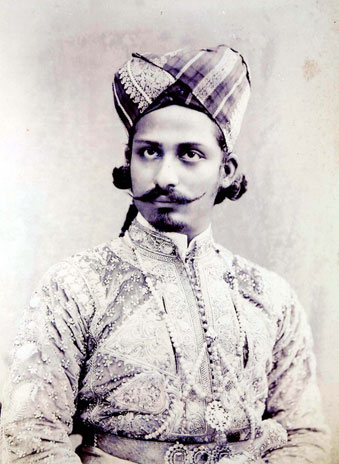 |
| Al Amir Omar bin Awadh bin Omar Al-Qu’aiti in his youth, 1890s. |
Omar died in Hyderabad in 1282H/1865 AD leaving behind a fortune estimated at several million rupees, and a Will dated 1279H/1863 AD in which he sought “God’s pleasure” by bequeathing one-third of it for purposes of the administration of his possessions or such that might come later under his or his successors’ jurisdiction and the establishment and promotion of general security and prosperity in Hadhramaut. He further appointed a triumvirate of three of his sons, Abdullah, Saleh and Awadh as his successors and trustees of the Will and instructed his other sons Mohammed and Ali to assist them and follow their instructions, while also compensating them both with a payment of rupees 250,000 each. Following Omar Al-Qu’aiti’s death, Ghalib Al Katheeri hurriedly assembled a large force and succeeded in taking Al-Shihr in early 1283H/1866 AD. He followed this up with an attack on the other coastal town of Al-Mukalla but was held back by its Kasadi (Yafa’i) ruler. The same year, the Qu’aiti under Omar’s son and chief general Awadh with the help of the Kasadi, attacked Al-Shihr from land and sea and put the Katheeris to flight. In 1284H/1867 AD a Katheeri attempt to retake Al-Shihr was repulsed by Awadh after a great struggle.
Awadh with the Kasadis’ help attempted in 1285H/1868 AD to take Sai’un, now the Katheeri capital, but this ended in failure after some early successes, chiefly due to internecine jealousies and feuding amongst Yafa’i ranks. This failure also brought to the fore the rift between the Qu’aiti and the Kasadi, who hitherto had been equipping his expeditions for service with the alliance with funds borrowed from the Qu’aiti.
An axis of Kasadi, Katheeri and Aulaqi was formed to oppose the Qu’aiti. The Aulaqi, Abdullah bin Ali (d. 1285H/1868 AD) and after him his son Mohsin were the chef rivals of the Qu’aiti as the senior most Jem'adars of Arabs at the Nizam’s court. The Aulaqis, although not indigenous to Hadhramaut had also dreams of empire building like the Katheeri and the Qu’aiti, and had bought in 1280H/1863 AD a strategically placed hamlet Sida’ between Al-Shihr and Ghail-Bawazeer. There they had built in the Indian fashion, the best fortress probably ever seen in Hadhramaut.
Awadh occupied the whole of the littoral east of Al-Shihr between 1287-88H/1870-71 AD. A Katheeri attempt to take Shibam in later 1291H/1874 AD was beaten back by Awadh’s elder brother Abdullah.
The Qu’aiti a reverse at Al-Tukhm in attempting to cut off a large Katheeri force marching to the aid of the Kasadi. He however defended Al-Shihr successfully against the three allies after some initial reveres and then, under Awadh’s command marched on to occupy Ghail-Bawazeer after drawing away most of its Katheeri defenders by a feint against Tarim in the interior. Sida’, the Aulaqi stronghold, which had been under siege contemporaneously with Ghail-Bawazeer was then taken in 1293H/1879 AD.
After finishing with the Aulaqi, the Qu’aiti decided to devote his energies to deliver the coup de grace to the Kasadi, using the reclaim of his loan of 160,000 Maria Theresa Thalers to which was added a further sum of 80,000 Thalers that had been accepted by the Kasadi as a price (i.e. a total of MT Thalers 240,000) for the sale of half of Al-Mukalla and his other coastal possessions including Burum. Later on, the Kasadi was to claim that he had agreed to this sale under duress.
The British in Aden at first suspicious of Qu’aiti ambitions and because of their own connections with the Kasadi sided with the latter. However, fed up ultimately with his failure to make arrangements for the repayment of the loan, and his use of threats to dispose of his possessions to foreign powers if the British did not take him under their protection, decided to support the stronger Qu’aiti, enabling him to take possession of Al-Mukalla for a final additional settlement of Maria Theresa Thalers 100,000 forced on the Kasadi, in addition to the previous "loans" amounting to 240,000 Maria Theresa Thalers. After his eviction, he left for Zanzibar. The Qu’aiti signed a Treaty of Friendship in 1299H/1882 AD followed by a Protectorate Treaty in 1305H/1888 AD with the British Government.
In 1316H/1899 AD the Wadi Do’an in the interior was brought under Qu’aiti control and in 1318H/1900 AD Wadi Hajar west of Mukalla (chiefly through the efforts of his eldest son Ghalib, acting on his father’s behalf as Regent).
Out of the triumvirate of bothers, Saleh, the eldest who had looked after the family’s interests at the court of the Nizam, died in 1294H/1877 AD and the second brother Abdullah in November, 1306H/1888 AD. During Awadh’s reign, his two nephews Munassar and Hussein the sons of Abdullah, had wanted the Sultanate to be divided, and this was opposed by Awadh. Several attempts at mediation were made, the most important one being by the “Mansab” of ‘Einat Ahmed bin Salim bin Sagas of the clan of Al-Sheikh Abu Bakar bin Salim (a spiritual figure of eminence) to whose arbitration both the parties had agreed initially, only for the award to be rejected by the two nephews, when they discovered that he had overruled the division of the Sultanate and upheld Awadh’s rights on the basis of the founder’s Will of 1279H, as the sole survivor of the triumvirate of Trustees named in that Document and the powers granted to him in it. The Mansab had awarded the two nephews in 1320H/1902 AD a handsome sum of money i.e. Maria Theresa Thalers 260,000 in compensation, which they rejected. In 1320H/1902 AD, the two brothers were exiled for interference with the Government and its finances and went to India from Aden in July 1322H/1904 AD after rejecting the Mansab’s award to file suits before the British Government and that of the Nizam of Hyderabad in India. The sum of the award was meanwhile deposited with the British, who invested it for the nephews, pending its acceptance and collection. In 1320H/1902 AD the title of Sultan was adopted by the British in their communications with Awadh bin Omar, whereas formerly, they used to address him by his Hyderabadi military title of Jem’adar.
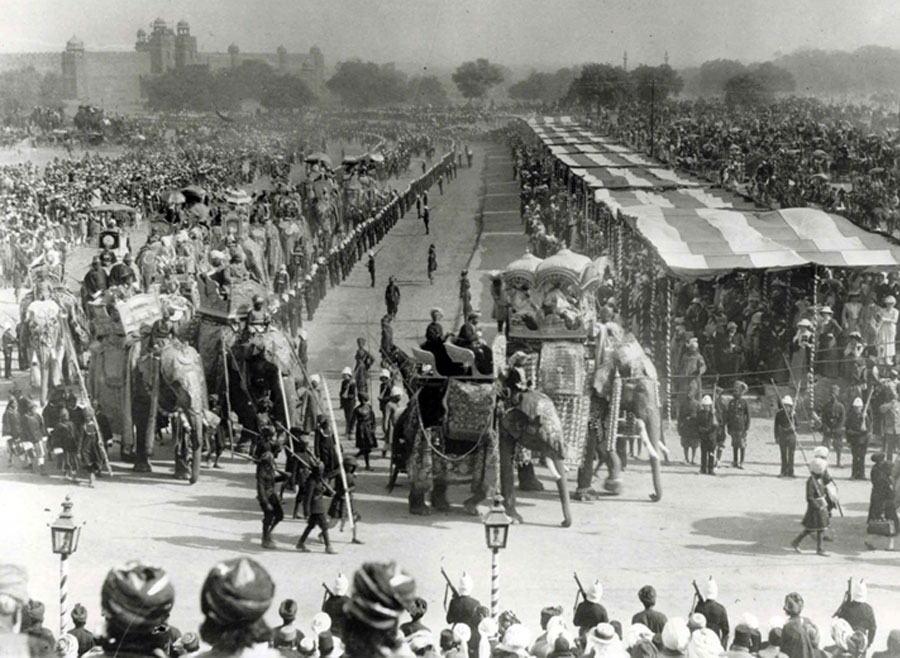 |
| The Imperial Delhi Durbar, 1903. The State Entry into Delhi, passing by the Jami’ Masjid. On the second elephant may be seen, Awadh bin Omar Al-Qu’aiti (the Sultan of Al-Shihr and Al -Mukalla) with Seyyid Hussein bin Hamid Al-Mihdar (his Wazir). |
 |
| Seef Airport, October 1929. Sultan Omar bin Awadh Al-Qu’aiti II with Captain Rickards en route to Wadi Masila standing next to a Fairey “Panther”. |
Awadh died in 1327H/1910 AD and was succeeded by his son Ghalib I. Ghalib, it must be noted was the prime mover in the subjugation of Wadi Hajar, when he was acting as Regent on behalf of his father during the latter’s absence in India. In his reign the telegraph was introduced, the army was reorganised along modern lines, and a geological survey was carried out by a British expert, O.H. Little, on loan from the Egyptian Government, in order to discover and develop the Sultanate’s potential in minerals and agriculture. His major political achievement was to sign a treaty with the Katheeris in 1336H/1918 AD in which while Katheeri dominion over Sai’un, Tarim and the Shanfari tribal confederacy was confirmed, Qu’aiti overlordship over the whole of Hadhramaut was recognised. An extremely generous man, Sultan Ghalib I was known as “Abuna Adam ‘Our father Adam’” or “Adam Abu’l Bashar ‘the father of mankind’” -out of regard for his generosity and kind disposition. He died in 1340H/1921 AD and was succeeded by his younger brother Omar, who ruled until the end of 1354H/1936 AD.
Omar II, a tough, romantic character is best remembered for the buildings he built in Hadhramaut – notably the Qasr al-Mu’een Palace and the Omar Mosque (paid for according to some by his wife and cousin, the daughter of Saleh bin Omar) – and for making the rounds of his capital in disguise, to find out facts for himself. Omar left behind five sons and was succeeded by his nephew Saleh the son of Ghalib.
Saleh has been described as the founder and father of Hadhramaut’s modern revival. He was acquainted with half a dozen languages and was the author of many works in Arabic on a variety of subjects ranging from religion and philology to engineering and nautical navigation. Saleh re-organised the Sultanate’s administration by creating departments for various functions each under director, and all reporting to a Wazir or State Secretary, who in turn reported to him. He gave the Sultanate a State Council to participate in government. In his reign the Sultanate was given a proper annual budget along modern lines, and he transferred most of his ancestral property to the state to augment its revenue, accepting for himself a civil list. Slaves were manumissioned, a step which they misunderstood and rebelled against – as in the past, they had been provided for, from the cradle to the grave – and education was given major importance to include formal schooling for girls- something unprecedented in Arabia at that time. Roads were built, the growth of tobacco and cotton experimented with and village, town councils and co-operatives introduced. The State itself was divided into 5 and later 6 provinces (singular in Arabic – ‘Liwa’), each under a ‘Naib’ of Governor and then sub-divided into districts each under ‘Qaim’ or District Commissioner. Prospecting for oil took place but was unsuccessful. In the hope of getting British advice, support and aid, Saleh had signed with them in 1937 an Advisory Treaty, which made the acceptance of their advice mandatory in all matters excepting religion. Succession to the throne based on primogeniture was also introduced with Sir Walter Monckton acting as his legal adviser.
 |
| Sultan Saleh Al-Qu’aiti before the footsteps of the Al Mukalla Palace in 1948 with the British Resident Adviser, CS Sheppard and the State Secretary, Sheikh Saif Al-Bu’aly taking the salute. In the middle of the next arch may be seen Omar Basaddiq and Sheikh Saeed Al Gaddal. The Hadhrami Bedouin Legion is marching past. Leading the march past is Captain Barakat. |
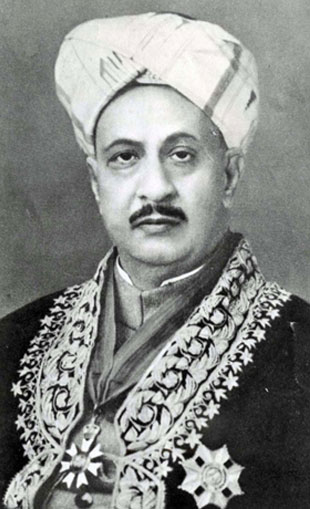 |
| Sultan Saleh bin Ghalib Al-Qu’aiti after receiving the British Knighthood of the KCMG (Knight Commander of the Order of St. Michael and St. George), 1940s. |
Saleh died in 1375H/1956 AD and was succeeded by his only surviving son Awadh, who ruled until 1386H/1966 AD. Awadh II will always be remembered for his simplicity, kindness and generosity.
In October 1386H/1966 AD, Awadh was succeeded by his son Ghalib, whose short reign should be remembered for having generated such goodwill amongst the people as to have managed to gather all the different tribes of Hadhramaut under the same roof for the first time for a tribal conference in 1386H/March 1967 AD to discuss the country's political future when they had unanimously supported the decision to remain an independent entity and not join the Federation. He was commonly dubbed as "Habib al-Sha'ab ", the Beloved of the People.
His refusal to join the British created Federation of South Arabia in keeping with the wishes of his subjects and the non-viability on financial grounds of such a course of policy and then again his objective in keeping with Hadhrami aspirations to work towards a union and his desire to work for a union between the two Hadhrami Sultanates of Qu’aiti and Katheeri with their eastern neighbour the Mahra as a preliminary step brought him into conflict with British policy. Thanks to the support and confidence they felt and enjoyed from their subjects, the Qu’aiti and Katheeri sultans had agreed to support the United Nations’ Resolutions on that region advocating a referendum to decide its future. However, they desired the United Nation’s Mission on South Arabia’s Independence Committee to visit the area and see the prevailing conditions before regulating blindly on its future from the comfort of Geneva and New York.
The British under the terms of the Advisory Treaty referred to above, “advised” the Sultans to go to Geneva “to apprise the United Nations’ Committee of their views regarding independence and the future”, and the acceptance of this advice was mandatory for the rulers and always supposed to be in the best of their interests. Meanwhile, they were also informed that the date for independence had been tentatively fixed for 8th January 1967, until which, all treaties were to remain valid, and that such British presence as existed in Al-Mukalla at the time would be withdrawn to Aden upon the closure of the British Residency on 10th October 1966.
The Sultans reluctantly left for Geneva via Aden where they were flown in a RAF aircraft especially sent for the purpose in late July and on arrival in Geneva, via Cairo, were alarmed to receive a message advising them of sudden British withdrawal from Al-Mukalla to Riyan airport and from there to Aden. The Sultans, after seeing the United Nations Committee wanted to fly back to their country but were informed that, for “technical reasons”, they could not be flown back to Al-Mukalla from Aden, although they had been flown out by the British!
Their attempt to land at Al-Mukalla by sea was blocked by the Hadhrami Bedouin Legion (a force under British Command and in their pay) on 17th September 1967.
 |
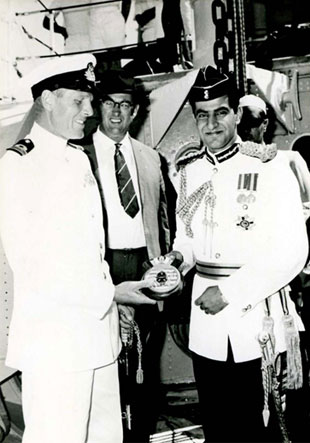 |
| Al Amir Ghalib bin Awadh Al-Qu’aiti, 1966 in the Cadet Corps Force uniform. Photograph taken at Shapwick House, Millfield School, Somerset, UK. |
Morning visit to HMS Kildarton on December 2, 1966. Sultan Ghalib bin Awadh Al-Qu’aiti II is presented with the ship’s crest as a memento by the Captain. In the middle stands Jim Ellis (Resident Adviser) and behind Sultan Ghalib bin Awadh Al-Qu’aiti II stands Sayyid Ahmad Al-Attas (Wazir). |
Support by loyal tribes to secure a passage overland from Saudi Arabia was put paid to by early October, when the British Royal Air Force carried out “fire power demonstrations” against the loyal tribesmen in support of the Hadhrami Bedouin Legion acting against these loyal tribes. It was to emerge much later on that when Sultan Ghalib had complained to U Thant (the then Secretary-General of the United Nations) about these unwarranted acts in support of a force acting against the interests of the ruler, by virtue of treaties whereby the British had access to the region, Lord Caradon, the British representative at the United Nations, was to go on to falsely maintain that these tribes acting against the above-named indigenous force were not actually the subjects of the Sultan.
Finally in November 1967, the British handed over the States of Qu’aiti, Katheeri and Mahra to the Aden based National Liberation Front, in whose favour the Hadhrami Bedouin Legion had been ordered to come out. The amazing factor here was that, all this was happening while the British were still legally bound by treaty to the Sultans (i.e. before 8th January 1968) and after they had claimed to have pulled out from Hadhramaut for good.
The last Katheeri Sultan, Hussain bin Ali, died in Jeddah followed by his eldest son Ali and his younger son and is survived by Faisal. The Qu’aiti Sultan, Ghalib II who later proceeded to do a degree at Oxford and then at Cambridge Universities, now lives in Saudi Arabia and has a son Saleh (born 1977) and two daughters.
The rulers of Al-Shihr and Al-Mukalla were later addressed as Sultans of the Qu’aiti State in Hadhramaut since the mid-1950s as their territory covered four fifths of Hadhramaut.
They initially minted their own metallic (gold, silver, copper) coinage until the 1910s when minting was stopped and Indian currency used until the 1950s to be followed by the East African currency and in the mid-1960s, the South Arabian.
They had their own postage stamps and passports, as did the Katheeri Sultans.
 |
| Second tour of the Interior, 1965. Al Amir Ghalib bin Awadh Al-Qu’aiti’s visit to the ancient metropolis of Shabwa, former capital of ancient Hadhramaut. |
 Al-Mukalla Harbour in the 1950s
The Yafa’is from times immemorial had a tradition for hiring themselves out as mercenaries and it was in this capacity that they were initially introduced into Hadhramaut in the 10th, 11th and 12th centuries of the Islamic Hijra (H) to assist local princes defend themselves, establish and assert their authority and to maintain law and order for them.
The ancestors of the Qu’aiti dynasty had come to Hadhramaut with these mercenaries and had been settled at a small village Lahroom not far from Shibam, the legendary town with the mud skyscrapers.
Some tradition has it that Awadh bin Abdullah Al-Qu’aiti the father of the founder of the Qu’aiti dynasty had travelled to India and served as a soldier with the Nizam of Hyderabad, dying in battle during the Second Mysore War against Tipu, the Sultan of Mysore. He left behind five sons and several of them travelled to India to seek fortunes as mercenaries.
Omar bin Awadh the founder of Qu’aiti fortunes was born at Lahroom in the 1790’s and is recorded to set off for India in 1228H/1813 AD. He took up service as a “Jem’adar” (Captain of a Group) at the court of the Raja of Nagpur (Berar – with an area of 80,000 sq. miles), where his brother Abdullah was serving. His arrival coincided with his brother’s death and Omar succeeded to his brother’s command and also married the latter’s childless widow.
On the defeat and capture of the Raja Appaji, Omar decided to evacuate the fort in lieu of the settlement of his troops’ arrears and on the condition that, his men would be allowed to march out with their weapons and belongings and escorted into any neighbouring territory of their choosing with a safe passage for those who intended to return home. They were to choose the Nizam's Dominions.
Al-Mukalla Harbour in the 1950s
The Yafa’is from times immemorial had a tradition for hiring themselves out as mercenaries and it was in this capacity that they were initially introduced into Hadhramaut in the 10th, 11th and 12th centuries of the Islamic Hijra (H) to assist local princes defend themselves, establish and assert their authority and to maintain law and order for them.
The ancestors of the Qu’aiti dynasty had come to Hadhramaut with these mercenaries and had been settled at a small village Lahroom not far from Shibam, the legendary town with the mud skyscrapers.
Some tradition has it that Awadh bin Abdullah Al-Qu’aiti the father of the founder of the Qu’aiti dynasty had travelled to India and served as a soldier with the Nizam of Hyderabad, dying in battle during the Second Mysore War against Tipu, the Sultan of Mysore. He left behind five sons and several of them travelled to India to seek fortunes as mercenaries.
Omar bin Awadh the founder of Qu’aiti fortunes was born at Lahroom in the 1790’s and is recorded to set off for India in 1228H/1813 AD. He took up service as a “Jem’adar” (Captain of a Group) at the court of the Raja of Nagpur (Berar – with an area of 80,000 sq. miles), where his brother Abdullah was serving. His arrival coincided with his brother’s death and Omar succeeded to his brother’s command and also married the latter’s childless widow.
On the defeat and capture of the Raja Appaji, Omar decided to evacuate the fort in lieu of the settlement of his troops’ arrears and on the condition that, his men would be allowed to march out with their weapons and belongings and escorted into any neighbouring territory of their choosing with a safe passage for those who intended to return home. They were to choose the Nizam's Dominions.








